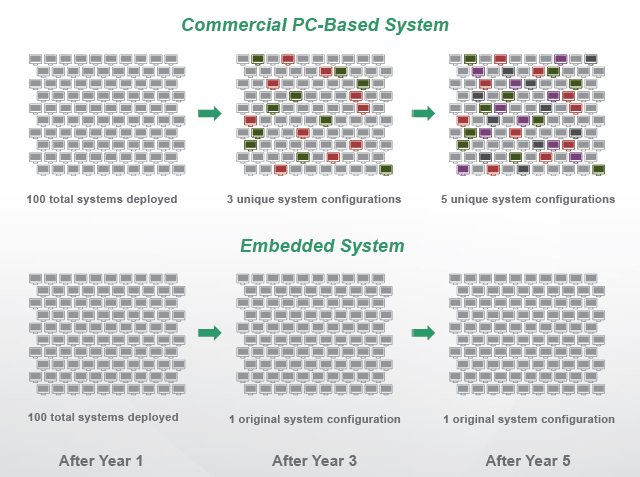- Home
- Symmetry Blog
- Why AMD Embedded - Part 7 of 9 in a Series Presented by Symmetry Electronics and SemiconductorStore.
Why AMD Embedded - Part 7 of 9 in a Series Presented by Symmetry Electronics and SemiconductorStore.com
Wednesday, March 20, 2013
The following is an example of an embedded application deployment containing a relatively small network of 100 digital signage systems. Let’s compare how the solution would be deployed and supported over the first 5 years of operation using a standard commercially available PC-based solution and a true AMD Embedded solution.
Below shows the assumptions used in this example:

Key parameters to consider when comparing TCO between a PC-based system and an Embedded system for a typical Digital Signage Application deployment.
Note 1: Failure rate assumptions are based on embedded player solutions being designed for reliable 24/7 operation in a typical digital signage environment while a typical PC is not designed for 24/7 operation in this same environment. A typical digital signage environment often includes enclosed cabinets to block out dust, and installation in areas that are not temperature controlled. Actual failure rates may vary.
Note 2: Unit price reflects typical cost for player hardware only not ncluding the display(s), software, network bandwidth, or content licensing costs.
Note 3: Energy costs are based on U.S. commercial energy cost average of $.01/kwh as per U.S. Department of Energy guidelines. Typical PC system power consumption assumed to be 190w (150w for system components plus 40w based on energy star power supply rated at 80% efficiencyvi. Typical AMD-based embedded system power consumption assumed to be 66w (60w for system components plus 6W based on typical DC/DC power supply at 90% efficiency)
Note 4: Aberdeen Group, The Evolution of Remote Product Service - April 2009. Found an average cost of a service dispatch to be $276.
At the end of Year 1, the PC-based system would have 10 devices replaced due to failures and the Embedded system would have 5 devices replaced.
At the end of Year 3 however, the situation has changed significantly. For the PC-based system, additional failures in years 2 and 3 (10/year) and unavailability of the original platform after the first 12 months contribute to having a total of 30 systems that have been replaced and 3 unique HW/SW configurations that now have to be supported within the network. Conversely, for the Embedded system, failures result in only 15 systems being replaced and all with the original HW/SW configuration.
At the end of Year 5, the PC-based deployment is now comprised of only half of its original systems and 5 unique configurations to maintain, whereas the Embedded deployment retains 75 of its original systems and all systems still have the same configuration.

5-year Deployment Comparison between a Commercial PC and Custom Embedded Solution
An example of an embedded application deployment containing a relatively small network of 100 digital signage systems as deployed and supported over a 5 year period will be presented in part 7 of our series.
In part 8 of our “Why AMD Embedded” series, we will present a more in depth analysis of the PC vs. Embedded cost comparison and demonstrate the potential cost savings of an AMD Embedded system over a five year period with significant savings potential beginning as early as year 2.
Symmetry Electronics (and its e-commerce division: SemiconductorStore.com) is an authorized AMD Embedded distributor.